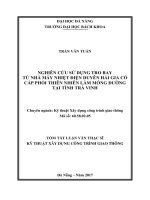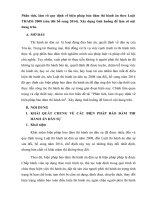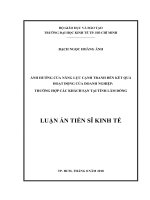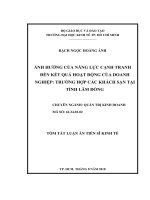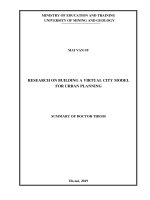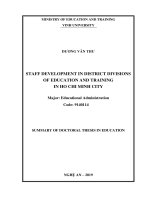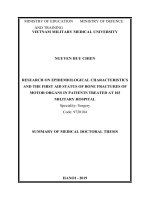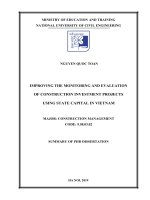TÍN DỤNG NGÂN HÀNG THƯƠNG MẠI đối với NÔNG NGHIỆP ỨNG DỤNG CÔNG NGHỆ CAO TẠI TỈNH LÂM ĐỒNG tt tiếng anh
Bạn đang xem bản rút gọn của tài liệu. Xem và tải ngay bản đầy đủ của tài liệu tại đây (889.49 KB, 33 trang )
MINISTRY OF EDUCATION AND TRAINING THE STATE BANK OFVIETNAM
BANKING UNIVERSITY OF HO CHI MINH CITY
COMMERCIAL BANK CREDITS
FOR HIGH-TECH AGRICULTURE
IN LAM DONG PROVINCE
DAO DUNG TRI
DOCTORAL THESIS SUMMARY
HO CHI MINH CITY, 2020
MINISTRY OF EDUCATION AND TRAINING THE STATE BANK OFVIETNAM
BANKING UNIVERSITY OF HO CHI MINH CITY
COMMERCIAL BANK CREDITS
FOR HIGH-TECH AGRICULTURE
IN LAM DONG PROVINCE
DAO DUNG TRI
DOCTORAL THESIS SUMMARY
Major: Finance – Banking
Code: 9 34 02 01
Scientific supervisor: ASSOC. PROF. PH.D. NGUYEN THI LOAN
HO CHI MINH CITY, 2020
1
LIST OF PUBLISHED SCIENTIFIC WORKS
1. "Dealing with bad debt of Vietnam commercial Bank, situation and
recommendation", Asia Pacific Economic Review. ISSN 0868-3808, 479, 4-7, 2016.
2. "Commercial bank credits for high-tech agriculture in Lam Dong Province", Industry
and Trade Magazine. ISSN 0866-7756, 20, 316-319, 2019.
3. "Integrated model explaining the granting of credit facilities intention tohigh-tech
agriculture", Review of Finance. ISSN: 2615-8973, 1st issue,Dec-2019 (718), 201-105,
2019.
2
CHAPTER ONE: RESEARCH OVERVIEW
1.1. Reason for choosing topic
1.1.1.
Research background
High technology agriculture (high-tech agriculture) is a step forward in agricultural production.
Lam Dong Province has a very favorable climate and suitable land to develop high-tech
agriculture. By the end of 2018, the total area of high-tech agriculture production in Lam Dong
Province is 54,477 ha (19.5% of province’s total farming area).
The high-tech agriculture program has been identified as one of 6 key programs for leading and
directing implementation since 2004. Thus far, the Provincial committee and the People's
Committee (PPC) has issued many advocates and policies aimed at promoting the development of
agriculture in the direction of high technology application. With the advantages and input of the
whole political system, Lam Dong is using its advantages to develop the high-tech agriculture area
to produce vegetables and flowers, thereby improving the productivity and value of products.
According to Lam Dong Department of Agriculture and Rural Development, there are more than
700 hectares that grow vegetables or flowers have revenue from 01 to 03 billionVND per year,
some areas even have revenue more than 3 billion VND on a hectare per year. High-tech
agricultureproduction requires huge investment capital, to achieve the revenue over 03
billion/ha/year, each hectare of production land should invest in the greenhouse system, irrigation
system, machinery from 2.2 billion to 2.5 billion VND.
Statistics from the State Bank of Vietnam - Lam Dong Branch showed that from 2012 to 2018,
localcommercial bank’s branches in the province of Lam Dong have lent only 1,021 billion to
develop high-tech agriculture. This capital was providedjust about 20% of the credit demand for
high-tech agricultureproduction of the whole period (4,837 billion VND). Although the province
has many advantages to develop high-tech agricultureand high-tech agriculturedevelopment is
under the concerned of Provincial Commission and the PPC. It was put into focus program, and
was a key to develop in each period.However, the amount of credit from commercial banksput into
this area in the recent years is very limited.
According to Boucher et al (2007), Diagne et al (2000), the credits provided by the commercial
bank have played a very important role in increasing agricultural productivity. It helps farmers
invest in production tools andtechnological innovations, and also in applying new technologies in
agriculture to increase their production efficiency and income. Therefore, identify the knots in
credit grading system ofcommercial banks in Lam Dong Province for high-tech
agricultureproduction is a pressing matter.
1.1.2.
Overview of related research and scientific gap
1.1.2.1. International studies
Experimental studies about agricultural credit constraints and borrowing behavior of farmers in
rural Punjab by WaqarAkram, Zakir Hussain, MH Sial and Ijaz Hussain (2008). The study of
Rabah (2015), about factors affecting the bank credit of Jordanian commercial banks.The study by
Firas Mohammed Al-Rawashdeh, Al Balqa; Burhan M. Al-Omari et al (2013) on the factors
affecting granting of credit facilities in commercial banks in the Aqaba Special Economic Zone Jordan. Study on credit for farmers in five districts of Malawi byDiagne and Manfred Zeller
(1999). Study by Duong and Inzumida (2002) on commercial bank credits for farmers in three
provinces of Vietnam (NinhBinh, QuangNgai and An Giang). Study byGuangwen and Lili
(2005),about the financial needs of farmers in Longren, Guizhou, China. Study by Nuryartonoet al
(2005) on credit rationingof farm households and agricultural production: empirical evidence in
the rural areas of Central Sulawesi,Indonesia. Study byQuartey et al (2017), about financing the
3
growth of SMEs in Africa: the contraints to SME financing within ECOWAS. The study by
Harvie et al. (2013),about SME’ access to finance: evidence from selected Asian economies, etc.
1.1.2.2. Domestic studies
The study by Nguyen Quoc Oanh, Pham Thi My Dung (2010), about determining factors affecting
farming households’ ability to access commercial bank creditsin suburban of Hanoi city.The study
of Tran Thuc and Huynh TrungThoi (2013) about factors affecting farmer’s access to formal credit
in AnGiang province. Study by Nguyen Ngoc Tuan (2012) about credit for coffee producers in
DakNong Province. Study by Mai Thi Thuy An, Phan Thi Ngoc Huyen and Nguyen Van Vu An
(2016),aboutSMEs capitals demand from commercial banks in TraVinh city. Study by Thai Anh
Hoa (1997) about the rice farmers’ accessibility to formal credit in An Giang and Can
Thoprovince. Study by Tran ThoDat (1998),aboutfactors affecting famers’ formal credit
accessibility in Vietnam. Study by Tran Ai (2009), about factors affecting commercial bank
creditsof aquaculture farms in TraVinh province. Study by Vo Thanh Danh (2008),about the
accessibility to commercial bank creditsof private companies in the Mekong river delta. The study
byTruong Dong Loc and Tran Ba Duy (2010),about the factors affecting the formal credit accessof
farmers in KienGiang province. Study by Nguyen Thi Hai Yen (2016),about the coffee producers’
accessto credit from commercial banksin Dak Lak Province. Study by Nguyen Thi Tam (2006),
about theimportant role of commercial banks’crediton developing farm economy. Study by Le
Dang Lang, le Tan Buu (2014), about the attitude of farmers on high-tech agriculturedevelopment
in DakNong Province. Study by Nguyen Van Tuan (2015),about the factors affecting credit quality
inAgribank. Study by Tran Quang Van et al (2017), about SMEs’ ability to access financial
resources, etc.
1.1.2.3. Review on previous studies
After reviewing domestic and foreign studies, the thesis includes some comment as follows:
Firstly, there have been many studies about credit activities in Vietnam as well as abroad. These
studies have shown factors affecting credit grade activity, access to the commercial bank credits
capital suitable for each audience and research location. However, the majority of these studies
only focus on one perspective. From perspective of the lenders- commercial banks, we have the
studies of Mpuga, Paul (2008), Harvie et al (2013), Firas Mohammed Al-Rawashdeh, Al Balqa,
Burhan M. Al-Omari et al (2013), Quartey et al (2017), Mai Thi Thuy An et al (2016), Vo Thanh
Danh (2008), Doan Thi Hong Dung (2012), Nguyen Van Tuan (2015), Nguyen Thi Hai Yen
(2016). From the manufacturing household's perspective, there are studies of WaqarAkram, Zakir
Hussain, MH Sial and Ijaz Hussain (2008), Guangwen and Lili (2005), Nuryartono et al (2005),
MamoGirma et al (2015), Mpuga Paul (2008), Diagne and Manfred Zeller (1999), Duong and
Inzumid (2002) , Nguyen Thi Hai Yen (2016), Vuong Quoc Duy and Dang Hoang Trung (2015),
Truong Dong Loc and Tran Ba Duy (2010), Tran ThoDat (1998), Thai Anh Hoa (1997), Tran Ai
Ket and Huynh TrungThoi (2013) etc.,and from the perspective ofcompanies and farm owners,we
have the research of Harvie et al (2013) , Quartey et al (2017), Tran Quang Van et al (2017),
Nguyen Hong Ha, Huynh Thi Ngoc Tuyen, Do Cong Binh (2013), etc. However, there are not
many extensive and comprehensive study about commercial bank credits grading activity from
both sides, customers and commercial banks.
Secondly, there have been a lot of studies on credit activities for agricultural production in
Vietnam as well as abroad. However, there have not been much intensive studies on developing
commercial banks’ lending. There are studies of high-tech agriculture but the research subject is
inclined to orient and the concerns when developing high-tech agriculture, such as the study by Le
Dang Lang, Le Tan Buu (2014).
4
Thirdly, some studies specialize in the role of bank credit in agricultural production such as the
studies by Boucher et al (2007), Diagne et al (2000), Nguyen Thi Tam (2006) etc.
Fourth, previous studies have mentioned and described quite specifically the causes that can lead
to grant capital funding and the factors affecting the needs and satisfaction of credit for the hightech agriculture household credit todevelop rural agriculture. However, previous studies has only
focused on explaining objective factors that affect the granting of credit facilities, such as land
size, land value (Duong and Inzumida, 2002; WaqarAkram, Zakir Hussain, MH Sial and Ijaz
Hussain, 2008;Diagne and Manfred Zeller, 1999; Tran ThoDat, 1998), scale of the business,
business area (Harvie et al, 2013; Quartey et al, 2017; Vo Thanh Danh, 2008), lending procedure,
collateral (Vo DucToan, 2012; Nguyen Hong Ha, Huynh Thi Ngoc Tuyen, Do Cong Binh, 2013),
credit policy, marketing policy (Doan Thi Hong Dung, 2012; Nguyen Van Tuan, 2015, etc.) or
demographic factors, such as age, gender, education level (Mpuga, Paul, 2008, Guangwen and
Lili, 2005; Tran ThoDat, 1998; Tran Ai Ket, 2009, Truong Dong Loc and Tran Ba Duy, 2010,
etc.), number of family members (Duong and Inzumida,2002; Diagne and Manfred Zeller, 1999;
Nuryartonoet al, 2005;Truong Dong Loc and Tran Ba Duy, 2010; etc.). However, these studies
didn’t concern about subjective perception factors of individual commercial bank employees.
Therefore, from the results of the above studies, it is difficult to propose the implications of
governance for the commercial bank leaders in order to increase the loan intention of customers,
understanding the behavioral intention of credit officers in granting credit and to maintain credit
growth in this area.
Based on the research background as well as gaps in previous scientific works, the author chose
the topic for thesis “Commercial bank credits for high-tech agriculture in Lam Dong Province".
This thesis is aimed to overall study the commercial banks’ granting of credit facilitiesin three
aspects.Firstly, in term of the commercial bankin the role of credit financing unit.Secondly, in
terms of the customer that usecredit loan service ofcommercial bank.And finally, in term of credit
officer.Therefore,this study on the credit from commercial bank for high-tech agriculturein order
to boost the commercial bank credits growth in high-tech agriculture area; this also contribute to
the development of high-tech agriculture in Lam Dong Province. This thesis has in-depth
differences in the field of study and scientific and practical meaning to apply in Lam Dong
Province.
1.2. Research objectives and research questions
1.2.1.
Research objectives
•
General objectives
Evaluategranting of credit facilitiesto high-tech agriculture activities from three perspectives:
commercial bank as credit financing unit, customer approaching capital, and the granting of credit
facilitiesintentionof the credit officer; in order to propose solutions and recommendations to
developcommercial bank’ credit for high-tech agriculture in Lam Dong Province.
•
Specific objectives
(1) Evaluate the status of granting of credit facilities tohigh-tech agriculture activities of
commercial banks in Lam Dong Province in 2012-2018 period to draw preliminary achievements
as well as the remaining problems that need disassembly;
(2) Evaluatethe accessibility and demand of commercial bank credits for high-tech agriculture
customers;
(3) Evaluate the factors affectedgranting of credit facilitiesintention from commercial bank credit
officers for high-tech agriculturein Lam Dong Province;
(4) Propose solutions and recommendations to develop commercial bank’ credit for high-tech
agriculture in Lam Dong Province.
5
1.2.2.
Research questions
• What are the achieved results and remaining limitationsthat affectgranting of credit facilities
activities of the commercial banks for high-tech agriculture in Lam Dong Province?
• Which difficulties and barriers that affect access to bank credit demand from customers who
need capital for high-tech agriculture in Lam Dong Province?
• What causes affectedthe development of commercial bank credits capital for high-tech
agriculture in Lam Dong Province?
• What are the solutions todevelop commercial bank creditsfor high-tech agriculture in Lam Dong
Province?
1.3. Research objective and research scope
1.3.1.
Research objective
Activities of commercial bank’ granting of credit facilitiestohigh-tech agriculture in Lam Dong
Province.
1.3.2.
Research scope
Study the bank credits in lending field for high-tech agriculture at commercial banks in Lam Dong
Province.
In terms of space: the scope of data and the scope of study is limited to Lam Dong Province.
In terms of time: usage data for study is aggregated in the period between 2012 and 2018. The
survey aimed to customers and credit officers at commercial banks in Lam Dong Province was
made in 2019.
•
Secondary data is collected from 2012 – 2018 to assess the current status of lending to
high-tech agricultureat the commercial bank branches in Lam Dong Province.
•
Survey period was from 3/2019 to May 8/2019. The survey object were credit officers
working in commercial bank branches. Scope of the survey was Dalat city and its four neighboring
districts: Lac Duong, Don Duong, Lam Ha and DucTrọng (will be referred to as “survey area” in
this study). The survey area is the region havehigh-tech agriculture focus mainly in Lam Dong
Province.Survey area has 95% total land that grows vegetables and flowers in Lam Dong
Province. The survey object are the individual business household, business, co-operatives groups
operate in flowers and vegetable production, who has demand for bank credit, excluding
enterprises with direct foreign investment capital.
1.4. Research methods and data collection
1.4.1.
Research methods
•
Research secondary data method, statistics, synthesis, comparison and analysis
(implementing objective 1).
•
Text analysis method (implementing objectives 1,4).
•
Customer survey methodandIPA grid analysis (implementing objective 2)
•
Commercial bank credit officer survey method and quantitative method to evaluate the
factors affecting the intention of granting of credit facilities (implementing objective 3).
•
Methods of analysis, synthesis, comparison and evaluation to form the foundation of
proposed solution recommendations (implementing objective 4).
1.4.2.
Data collection
•
The secondary data taken from summary report of the State Bank of Vietnam in Lam
Dong Province, commercial banks and the annual statistics of Lam Dong Province, from 2012 to
2018.
•
Primary data to verify the intention of the credit officer’s granting of credit facilities
behavior from the sample set of 358 credit officer surveys in survey area.
6
•
Primary data to assess the needs, current loan status andpurpose of using the loan, and
the difficulties that customershave, etc., which wascollect from the sample set of 161 survey of
farmers and businesses.
1.5. New points and contributions of thesis
1.5.1.
New points
First, this thesis analyzed and reviewed commercial bank credits activities in Lam Dong
Province with three perspectives: commercial banks as capital funding unit, the demand capital
from customer’s perspective and factors affecting the capital granting intention of credit officers.
Second , this thesis has approached the theory of behavior and inherited integrated models to
construct a model that quantitative factors explaining the granting of credit facilities intentionby
credit officers forhigh-tech agriculture in Lam Dong Province from the survey results.
Third, thisthesis has discussed and given the commercial bank credits concept for high-tech
agriculture, the characteristics of high-tech agriculture production and its lending features.
Four, this thesis used combining data from primary source and secondary source with
multiple analytical methods to find out the difficulties, challengingissuesofboth supply and
demand in term of bank credit facilities for high-tech agriculture.
1.5.2.
Scientific contributions
First,build asystematic theoretical frame of high-tech agriculture and commercial bank
credit, and from which evolved into the theory aboutcommercial bank credit of high-tech
agriculture production.
Second, systematizeinterpretation of theoretical frameworks of behavior, evaluation,
inheritance of experimental studies to formulate models explaining the factors affecting the
decision of the credit grade of staff.
1.5.3.
Contributions in terms of practice
•
The thesis has provided more information about the current status of agricultural credit
activities, especially the high-tech agriculture in Lam Dong Province.
•
Point out the difficulties in the loan process for high-tech agriculture and the
obstructions in credit activities and help the commercial banks in Lam Dong Province to build the
business strategy.
•
Provide useful advices and recommendations to build policies for promoting credit
growth of other industriesatcommercial banks in Lam Dong Province.
1.6. Thesis structure
Chapter 1: Thesis overview
Chapter 2: Theoretical background
Chapter 3: Research Methods
Chapter 4: Data analysis
Chapter 5: Conclusions and solutions, recommendations
Chapter one Conclusion
Chapter 1 has introduced the reason and practical necessity of research on commercial
bank credits for high-tech agriculture in Lam Dong Province. After reviewing relevant domestic
and foreign studies, Chapter 1 found scientific gap; and with that background, determines the
content, objectives, subjects, scope and methods of research; contributions to scientific and
practical research. Chapter 1 is the foundationto performresearches in next chapters.
7
CHAPTER TWO: THEORETICAL BACKGROUND
2.1. High-tech agriculture overview
2.1.1.
The concepts and features of high-tech agriculture
2.1.1.1. The concepts of high-tech agriculture
•
The concept of high-tech agriculture
According to Pham S (2006), "High-tech agriculture is agricultural application
synthesis of new kinds of technologies suitable with faming space condition at specific time and
the advanced technical facilities to achieve optimum productivity, quality, food safety and cost of
production. Therefore, it helpsincrease competitiveness with high economic efficiency on the basis
of ensuring sustainable ecological environment”.
•
Concept of high-tech agriculture area
•
Concept of high-tech agriculture region
•
Concept of high-tech agriculture business
•
Concept of high-tech agriculture farm
•
Concept of high-tech agriculture household
•
Concept of high-tech agriculture project
•
Concept of the agricultural production value chain
2.1.1.2. The features of high-tech agriculture
First, high-tech agriculture produces new breed seedlings with high yield, good quality and shorter
growth time.
Second, high-tech agriculture creates new production methods thatconcentrate andcreate large
quantity of goods. Businessescan catch up with each other in terms of technology, skills and
specialized production line. Each phase of the production line can be operated by a specialized
business.
Third, when forming zones and regions that produce signature products canalso createagriculture
tourismattractions.
Fourth, the soil is gradually replaced by growing mediums or nutrient liquid. Thereby, the
hydroponic cultivation model using growing mediums becomes more popular.
Fifth, manual labor is slowly replaced by machines and high skilled labors into the production line.
Sixth, can producing large volume of evenly high quality goods. Therefore, it is possible to join the
global trade and value chain by meeting the market supply requirements and product quality and
origin traceability.
Seventh, fromeconomic perspective,the demand for credit capital from commercial banks would
rise due to the need in investingmore on machinery, equipment and modern technology. It will
increase the investment cost per unit area;
Eighth, the appearance of challenges such asthe follow-the-crowd feature of high-tech agriculture,
the poor quality products blended into market will do damage to the farmers.
Ninth, to form co-operation producing model between businesses, co-ops, co-ops group with
agriculture households for the matter of supply of materials, production and consumption.
Tenth, high-tech agriculture is the foundation to continuing into 4.0 eraof smartagriculture of
comprehensive, sustainable and modern.
2.1.1.3. The advantages of high-tech agriculture
2.2. Commercial bank creditstheoretical background
2.2.1.
Commercial bank credits concept
From the nature of credit and the concepts stated, it is possible to conclude that, Commercial bank
credits (on lending operations perspective) are the process that commercial banks use their own
capita or mobilized capital to make loans to legal entity and individuals with specified conditions
and for a certain period on which the two sides agreed upon the principle of repayment. When
due, the borrower is obliged to repay the original loan amount plus interest.
2.2.2. Classification of bank credits
According to Bui Dieu Anh et al (2009), bank credits classified as follows:
8
•
Based on credit purpose
Credit for business operation
Credit for consumption
• Based on credit deadlines
Short-term credit.
Medium-term credit.
Long-term credit.
• Based on credit collateral
Credit doesn’t havecollateral.
Credit hascollateral
• Based on the form of credit
Credit as money.
Credit as asset.
• Based on Repayment method
Installment credit.
Non-installment credit.
Credit repayment upon request.
• Based on repayment characteristic
Direct repayment credit.
Indirect repayment credit.
2.3. Overview of commercial bank credits to high-tech agriculture
2.3.1.
The concept of commercial bank credits to high-tech agriculture
Commercial bank credits (in lending operations) for high-tech agriculture is the process
that commercial banks ' use of their own capital or mobilized capital to make loans to legal entities
and individuals for high-tech agriculture with specified conditions and for a certain period on
which the two sides agreed upon the principle of return. When due, the borrower is obliged to
repay the original loan value plus loan interest rate.
2.3.2.
Features of commercial bank credits for high-tech agriculture
First, the scale and method of high-tech agriculture makes the cost of lending activities of
commercial banks dropped;
Second, when giving loans to high-tech agriculture, the high risk caused by nature and other
environment factors is no longer a major issue as traditional agricultural production;
Third,because of the large investment per unit area, the short-term loan for high-tech agriculture
can cause difficulties to the borrower when it is due;
Fourth, the evaluation of loan collateral in high-tech agriculture is generally low due to the right
ownership of establishments in the land was unspecified by the law;
Fifth, in terms of credit risk inlending to high-tech agriculture, the risk from natural force is not
much, but there still are risks come from technology, unstable market, and from the risk of capital
loss;
Sixth,high-tech agriculture chain value also enablecommercial banks to create niche high-tech
agriculture loan products, such as lending through value chains, lending through focal institutions,
lending to projects or co-operations, etc.
Seventh, the loans for high-tech agriculture are usually lower than its demand;
Eighth, high-tech agriculture lending requires the credit officer’s effort to grasp new technologies,
production processes, etc. to be confident in the evaluation and make credit proposals;
Ninth, purchasing contracts prior to the production is considered as important key to loan
evaluation and proposal in casesbusiness don’t have secured assets in high-tech agriculture
lending.
2.3.3.
The role of commercial bank credits for high-tech agriculture
2.3.4.
Developing commercial bank credits to high-tech agriculture
2.3.4.1. Perspectives on developing commercial bank credits for high-tech agriculture
9
Developingcommercial bank credits for high-tech agriculture needs simultaneously
developboth of its width and depth. Width developing is the growth in terms of credit volume,
credit structure, and high-tech agriculture credit customer segments. Depth developing is the
quality of credit facilities, quality of credit services, improve customer satisfaction and meet the
reasonable needs of high-tech agriculture customers based on loanrisk control.
2.3.4.2. Developing indicators of commercial bank credits in high-tech agriculture
Growth indicators on loan sales of high-tech agriculture
Growth indicators on loan outstanding balance of high-tech agriculture
Growth indicatorsabout high-tech agriculture customer quantity
Growth indicatorson evaluatehigh-tech agriculture credit quality
2.3.4.3. Factors affecting the development of commercial bank credits for high-tech
agriculture
Objective factors group of the commercial bank
•
Credit policy of commercial bank
•
The bank information technology system
•
Internal control system that related to credit activities
•
The bank marketing activities
•
Implementingcommercial bank credit activities and the quality of workforce
Subjective factorsgroup
•
Legal environment
•
Natural conditions and socio-economic environment
2.4. Theoretical frameworks of behavior
2.4.1.
The theory of planned behavior (TPB)
The theory of planned behavior was developed byAjzen and Fishbein (1980). The
planned behavioral theory is meant to interpret most human behaviors. According to TPB, the true
behavior of an individual in the conduct of a particular action is come frombehavioral intention of
said individuals.The intention of which is influenced by three main factors: attitude, perceived
behavioral control and subjective norm (Figure 2.1).
Figure 2.1 The theory of planned behavior (TPB)
Theory of Technology Acceptance model (TAM)
Technology Acceptance Model is also developed from the Theory of Reasoned Action
(TRA) by Fisbein&Ajzen (1975), according to TAM, a person acceptance behavior of using a
certain system is formed from their attitude toward using that system and their perceived
usefulness (PU) of said system. In which, the attitude and perception about system usefulness is
influenced by the perceived ease-of-use (PEOU).
2.4.2.
10
Figure 2.2The technology acceptance model (TAM)
2.4.3.
The Expectation – Confirmation Theory (ECT)
The Expectation – Confirmation Theory was proposed by Oliver (1980), see Figure 2.3 below.
According to the ECT model, customer’s post-purchase behaviors are formed on four steps. (1)
Expectations, (2) performance or quality of the product or service, (3) confirmation and finally,
perceived of the confirmation, then customer will form an attitude about said product or service,
that is the satisfaction.
+
Figure 2.3 Theexpectation – confirmation theory model (ECT)
2.4.4.
Theory of Perceived Risk
Featherman and Pavou (2003) defined perceived risk is the human perception of possible losses
when they pursue a specific goal.
2.4.5.
Integrated Models
2.4.5.1. Lee's Integrated Model (2009)
11
Figure 2.4 Lee's Integrated Model (2009)
Lee (2009) had integrated the TPB and TAM models while adding additional theoretical theories,
risk awareness – the perception of benefits to formulate an integrated model that explaining the
internet banking using intention of Taiwanese people's (See Figure 2.4). The integrated model has
been successfully tested through quantitative research and the prefixes of both TAM and TPB
models, such as perceived usefulness (PU), perceived ease of use (PEOU), subjective norm (SN)
and perceived behavioral control (PBC).They’re all contributed to the explain customer's attitude
and intention in choosing to use internet banking.
2.4.5.2. The integrated model of Bhattacherjee (2001)
Figure 2.5 Post-acceptance model
The post-acceptance model of Bhattacherjee (2001) has been verified by quantitative methods in
research context both in terms of customer acceptance and retention to online banking services in
12
the United States. The results of the study showed that Bhattacherjeehad successfully built the
validation scale and integrated it appropriately along with TAM model to explain customer
behavior.
2.4.5.3. The integrated model of Liao et al (2007)
Figure 2.6 Integrated model by Liao et al. (2007)
Author Liao and his associates had integrated the TPB and TAM theories to build a model to
explain the intention of continuing to use the online learning system (e-learning) of the students in
Taiwan (see Figure 2.6). The results of the study showed that the model was successfully built and
confirmed with all the theories being supported, and the model had explained 70% for the
intention of continuing to use the e-learning system of Taiwanese students.
2.5. Relevant studies assessment and inheritance
First, through the examination of the relevant experimental studies, thesis found that the
study byWaqarAkram, Zakir Hussain, MH Sial and Ijaz Hussain (2008) has a wide range of
suitable content in the purpose of study high-tech agriculture customer’s access to commercial
bank credit capitals; and integrated with group discussions between experts in banking sectors,
business owners, co-ops and farmer households. This thesis created customer surveys on the
demand of credit capitals for high-tech agriculture in Lam Dong Province, and used analysis tools
and methods to point out issues in the process of accessing credit capital of high-tech agriculture
customers.
Second, from behavioral theories and from analyzing three integrated patterns of behavior, with
the spirit to inherit anddevelop further the direction studies of mentioned Bhatteacherjee (2001),
Liao and Associates (2007) and Lee (2009), the author builds the theoretical research model as
shown in Figure 2.7 below.
Figure 2.7 Theoretical research model
In the research model, the final dependent variable of the model is the Behavioral intention (INT),
the intermediate dependent variables are: Attitude (ATT) and Perceived of Usefulness (PU). Five
independent variables of the model are: Perceived ease of use (EU); Perceived of Risk (RIS);
Subjective norm (NOR); Cognitive Behavioral Control (PBC) and Confirmation (CONF). The
result of above model can be present in following regression equations:
13
INT = α1 + β1ATT + β2NOR + β3CONF + β4PBC + Ɛ1
ATT = α2 + β5PU + β6EOU + β7CONF – β8RIS + Ɛ2
Two main research subjects are:
•
The intention to grant high-tech agriculture credit of credit officer who has never done
high-tech agriculture credit contract before.
•
The intention to continue to grant high-tech agriculture credit of credit officer who
did the high-tech agriculture credit contract before.
Conclusion of Chapter two
Chapter 2 introduces the theory of the commercial bank credit for high-tech agriculture and
explains the theoretical concepts involved. Based on analyzing and synthesizing previous research
models and behavioral theories, a research direction on customer credit demand is formed, and a
new theoretical research model is proposed. The research methodology and testing of specific
model will continue to be mentioned in Chapter 3.
CHAPTER THREE: RESEARCH METHODS
With the objective stated, the thesis has done two separate studies as follows:
3.1. The first research design
14
3.1.1. Research process
Figure 3.1 First research process
3.1.2. Research Method
3.1.2.1. Qualitative research
Qualitative research using group discussions to build the survey question.
3.1.2.2. Quantitative research
Quantitative research was done using a convenient (non-probability) sampling method. Data
collected will be analyzed using tools such as Excel and SPSS software.
3.1.3. Research sample
The research subject is the farm owners and business owners who are producing flower or
vegetables on the survey area. According to Nguyen DinhTho (2011), the minimum sample size
for quantitative research is n = 150. The thesis collects 161 surveys to perform descriptive
analytic.
3.1.4. Building questionnaires
The closing questions use measurable scale that are inherited from the previous study of Akram
and Hussain (2008) and other experts in the qualitative research.
3.1.5. Data analysis methods
Use methods of analysis, synthesis, comparison and evaluation.
3.2. The second research design
15
Figure 3.2 Second research process
3.2.2. Research model and assumptions
In the context of study high-tech agriculture credit of the thesis, the theoretical research model
proposed in Chapter 2 can apply to both of two research subjects:
-The intention to grant high-tech agriculture credit of credit officer who had never done high-tech
agriculture credit contract before.
-The intention to continue to grant high-tech agriculture credit of credit officer who did the hightech agriculture credit contract before.
3.2.2.1 The first research model
The subject of first research model is behavioral intention of granting credit to high-tech
agriculture customer of credit officer.
16
Figure 3.3 First research model
3.2.2.1 The second research model
The subject of second research model is behavioral intention of continuing to grant credit to hightech agriculture customer of credit officer.
Figure 3.4. The second research model
3.2.3. Research design
The research was conducted in two main steps: Preliminary research and formal research.
3.2.3.1. Preliminary research
Was conducted by two methods: qualitative and quantitative. The qualitative research was
intended to explore, moderate and complete the observed variables used to measure the concepts
of research. The qualitativeresearch was done through group discussion and deep interview.
Quantitative researchwas conducted for two purposes: first was to check the reliability of the
measure scale before conducting formal research, second was to estimate the response rate of the
survey subjects to predict the number of surveys may be obtained if doing surveys at the
commercial banks in the survey area.
3.2.3.2. Formal research
The formal research was conducted by quantitative methods with the survey subject was the credit
officer who never did and who didgranting high-tech agriculture credit. The collected data was
cleaned up and implemented analysis steps include: Reliability analysis with Cronbach’s Alpha
measure, exploratory factor analysis-EFA, and confirmatory factor analysis-CFA. The
consumptions of two research models will be tested by structural equation modeling (SEM).
Finally, using Bootstrapfeature to check the accuracy of the estimates in model.
3.2.4. Research sample
17
The research used the cluster sampling method, with the overall sampling subjects was all credit
officers who never did and who did high-tech agriculture credit contract at commercial banks in
survey area. 358 questionnaires were collected for formal research sample and divided into 2
groups, group 1 including 175 questionnaires were those credit officers who have not previously
granted high-tech agriculture credit and 183 questionnaireswere the credit officers who have
grantedhigh-tech agriculture credit.The sample size qualified minimum sample size (n = 150)
Nguyen DinhTho (2011).
3.2.5. Measure scale
The measure scale of theoretical concepts was inherited from the previous studies by Lee (2009)
and Bhattacherjee (2001), through qualitative research with experts to complete and correct the
content, in accordance with research context was credit activities at commercial banks. The
research used Likert measuring scale with 5 levels respectively (1: Completely disagree – 5:
Completely agreed).
3.2.6. Data analysis methods
The data was processed through two common steps on structural equation modeling (SEM) with
both measurement model and a structural model that were evaluated by software AMOS 22.0. The
measurement model was analyzed by the Cronbach’ alpha test and the exploratory factor analysis
(EFA) for preliminary assessment of the measure scale. The confirmatory factor analysis (CFA)
was used to verify composite reliability, convergent validity and discriminant validity and general
compatible rate of the scale. Structural model was used SEM technique with maximum likelihood
(ML) for estimating the overall relevance to the research model and the stated research
consumptions.
3.2.6.1. Descriptive analysis
3.2.6.2. Measure scale reliability analysis
3.2.6.3.Exploratory factor analysis (EFA)
3.2.6.4. Confirmatory factor analysis (CFA)
3.2.6.5. Testing the research model
Chapter Three Conclusion
Chapter 3 has designed and described the full range of research methods to fulfill four objectives
of the thesis, the research results is shown in Chapter 4.
18
CHAPTER FOUR: RESEARCH RESULTS
4.1.Overview of the socio-economic status and agricultural production in Lam Dong
Province
4.1.1. Natural condition of Lam Dong Province
4.1.2 Socio-economic status in Lam Dong Province
4.1.3. The status of high-tech agriculture production in Lam Dong Province
4.3.1.1. The status of agricultural production in Lam Dong Province
4.3.1.2. The status of high-tech agriculture production in Lam Dong Province
4.2. The status of the commercial bank credit development for high-tech agriculture in Lam
Dong Province
4.2.1. Overview of the activities of credit institutions in Lam Dong Province
4.2.2. Demand for credit in high-tech agriculture production in Lam Dong Province
The total capital to executethe high-tech agriculture program between 2001-2015 and 2016-2020
was 10,083,782 million dong. In which, the state budget capital was 3,174,000 million dong and
the capital mobilized from credit institutions, businesses and households was 6,909,782 million
dong. If the estimated demand for credit capital is about 70%, then total credit demand for hightech agriculture production in the phase 2011-2020 was about 4,836,847 million dong.
4.2.3. Status of credit for agricultural in countryside area at commercial banks in Lam Dong
Province
About agricultural in countryside area, total sales of agricultural in countryside area lending in
2018 was more than 104,949 billion dong, up 237.5% to the previous year 2017, increase
abundantly of 60,764 billion dong and went-up more than 80 times to the number in 2012.
In terms of outstanding loan balance to agricultural in countryside area, the total outstanding loan
balance in 2018 was more than 58,775 billion dong, up to 33.4% over the year 2017 with an
increase of 14,726 billion dong and went-up more than 25 times to of year 2012. Credit balance
growth of commercial banks in the agricultural in countryside areagrew average 71% per year.
4.2.4. The status of commercial bank credits for high-tech agriculture in Lam Dong Province
- In loan sales: The total loan sales of high-tech agriculturein the 2012-2018 period was 1,021
billiondong, averaged 255.2 billion/year (2015-2018).
Loan sales by commercial bank: with 26 commercial bank branches in Lam Dong province by
31/12/2018, there were 6 commercial bank branches had credit for high-tech agriculture with the
total loan sales in 2015-2018 was 1,021 billion dong. In which, the loan sales of AgribankLam
Dong was 474,504 billion dong, accounted for 46%; AgribankLam Dong 2 was 286,865 billion
VND, accounted for 28%; Vietinbank Lam Dong was 29,493 billion dong, accounted for 3%,
Vietcombank Lam Dong was 122,971 billion dong, accounted for 12%; Military Bank was 41,411
billion dong, accounted for 4% and Lien Viet Post Bank was 66,081 billion, accounted for 6%.
The proportion of loan sales for high-tech agriculture in total loan sales for agricultural in
countryside area: Figure 4.1 below shows that in the 2015 – 2018 period, loan sales proportion of
high-tech agriculture to total loan sales of agricultural in countryside area was very low (in 2015
was 1.489%; in 2016 was 0.374%, in 2017 was 0.791% and in 2018 was 0.342%).
19
Source: Summary of State Bank - Lam Dong Branch
Figure 4.1 Commercial bank loan sales proportion of agricultural in countryside area and
high-tech agriculture in Lam Dong Province
- Regarding the proportion of outstanding loan balance of high-tech agriculture to outstanding
loans balance of agricultural in countryside area: in 2015-2018 period, outstanding loan
balanceofhigh-tech agriculture accounted for very low percentage (0.255% in 2015, 0.264% in
2016, 1.267% in 2017 and 0.481% in 2018).
-Regarding customers of high-tech agriculture loans: the total number of customers received hightech agriculture loans in the 2015-2018 period was 798 customers.In which, there were 21
customerswerebusinesses and co-ops and 777 customers were households. The number of hightech agriculture customers in this period compared to agricultural in countryside area loan
customerswas very low (Businesses < 7% and households < 2%).In 2017, total customersreceived
loansfor high-tech agriculture pursuant toDecision No. 813 (loans with preferential rate) was 443
customers (8 businesses and 435 households). In 2018, the number was 18 customers (9 businesses
and 9 households).
-Regardinghigh-tech agriculture customers with outstanding loan balance: the number of hightech agriculture customers with outstanding loan balance accounted for 0.2% of total agricultural
in countryside area customers. The number of business customers with outstanding loan balance
was only 1.1% of total businesses customers with outstanding loan balance in agricultural in
countryside area.
-Regarding non-performing loans (NPLs) in agricultural in countryside area and high-tech
agriculture: NPLs of agricultural in countryside area in 2015-2017 period accounted for about
25% of total NPLs, and there was none NPLs of high-tech agriculture. In 2018, NPLs of
agricultural in countryside area accounted for 92.6% of total NPLs, and NPLs of high-tech
agriculture accounted for 1.47% of total NPLs in agricultural in countryside area.
4.2.5. Discussing the results of current high-tech agriculture bank credits in Lam Dong
Province
First, growth in loan sales and in outstanding loan credit balance of agricultural in countryside
area in 2012-2018 period was very high. Meanwhile, the growth in high-tech agriculture loan sales
was not much. The average increases was 36% per year; in the whole period, total high-tech
agriculture loans was 1,021,325 million, accounted for 0.51% of agricultural in countryside area
loan sales.
20
Second, growth in loan sales and outstanding loan balance in agricultural in countryside area and
high-tech agriculture spiked in 2 periods (2014-2015) and (2016-2017).
Third, the short-term debt in agricultural in countryside area and high-tech agriculture customers
still accounted for the majority.
Four, the number of agricultural in countryside area loanscustomers increased very quickly during
the whole period.Meanwhile, the number of high-tech agriculture loan customers wassmall (only
21 businesses, co-opswas borrowed for high-tech agriculture).
4.3. Results of customer survey on commercial bank capital access demand
4.3.1. Overview of the survey sample
4.3.2. Survey results
• Survey result on agricultural production characteristics
• Survey results on high-tech agriculture production
• Survey results of customers’ concerns when participating in high-tech agriculture
Table 4.1 Survey of customers’ concerns when participating in high-tech agriculture
Concerns
Quantity
Rate
Lacking of capital
134
83,2%
Lacking of businesses to buy veggies and flowers after
harvesting
102
63,4%
Unfocused product brand
84
52,2%
Lack of knowledge and experience
72
44,7%
Not understanding the current quality standards
61
37,9%
The mixing of the low-quality agricultural goods
47
29,2%
Lacking of management skills
38
23,6%
Lack of support from the government
33
20,5%
Lack of labor
24
14,9%
Do not know to choose which high-tech agriculture
product
19
11,8%
Unstable market
8
5,0%
Lacking of farm land
3
1,9%
Source: from survey results
• Customer survey results on access to capital credit
-Survey results aboutcommercial bank loan purposes for high-tech agriculture production
Table 4.2 Survey on loan purposes of high-tech agriculture loan customers
Loan purposes
Quantity
Rate
Investing on facilities (net houses, greenhouse, etc.)
62
82,7%
Investing on production system (machinery, irrigation systems,
lighting system)
57
76,0%
Production (seedlings, fertilizers, pesticide, labor salary, etc.)
54
72,0%
Paying debts
25
33,3%
Buying or renting agricultural land
16
21,3%
Other purpose
8
10,7%
Source: from survey results
•
Other funding sources of survey subjects
Table 4.3 Survey on subjects about other capital sources for
high-tech agriculture production
Other capital sources
Quantity
Rate
21
Buy on credit from suppliers
Borrow from relatives
Advance payment from buyers
Not using any others capital source
Participate tontine
Other credit sources
•
49,3%
45,3%
41,3%
17,3%
9,3%
6,7%
Source: from survey results
Survey results on the type of bank loans collateral
Table 4.4 Survey on subject’s loan collateral
Collateral type
House, real-estate
Agricultural land
Other people's collateral
Machinery, factory or private property
Non-collateral loan
•
37
34
31
13
7
5
Quantity
Rate
58
77,3%
21
28,0%
11
14,7%
7
9,3%
2
2,7%
Source: from survey results
Survey on customers don’t borrow from commercial banks for high-tech agriculture
production
Table 4.6 Reasons customers didn’t borrow from commercial banks
for high-tech agriculture production yet
Reasons customers don’t borrow from bank
Quantity
Rate
No need to borrow
35
40,7%
Already borrowed from other source
51
59,3%
There’s need but don’t know where to borrow
5
5,8%
Reason for non-approved loan
No collateral
2
2,3%
Insufficient production capacity
2
2,3%
Don’t know how to complete the loan application
20
23,3%
Poor loan propose
21
24,4%
Credit restriction policy of commercial bank
3
3,5%
Other reasons for not want to borrow
Bribing cost for credit officer
15
17,4%
Got other capital sources
46
53,5%
Don’t want to pay interest
14
16,3%
Complicated procedure
17
19,8%
Too far from the bank branches
6
7,0%
Costly procedure process
21
24,4%
Time-consuming to make propose and wait for
40
46,5%
approving
Source: from survey results
•
Survey result of difficulties when borrowing from commercial bank
Table 4.7 Survey of difficulties in commercial bank loan process
for high-tech agriculture production
22
Difficulties
Low evaluating collateral asset
Loan term is too short
Not many other forms of collateral
Approved loan amount is lower than need
Application take long time to approved
Must have collateral asset
Complicated procedure
•
-
Quantity
51
46
29
26
15
15
8
Rate
68,0%
61,3%
38,7%
34,7%
20,0%
20,0%
10,7%
Source: from survey results
Survey results about the quality of credit services for high-tech agriculture in Lam
Dong Provinces
Customer survey results about the importance of the credit service quality evaluation
criteria for high-tech agriculture
In order to understand the hindrances in agricultural credit financing process of commercial
bank, the thesis used Importance-performance analysis.
Table 4.8 Evaluation criteria used in importance-performance analysis
Credit
Level of
Symbol
Evaluation Criteria
service
importance
quality
X1
Loan interest rate
4,37
3,11
X2
Loan procedure
4,37
3,31
X3
Loan approval time
4,60
3,17
X4
Maximum loan amount
4,67
3,17
X5
Loan term
4,60
3,32
X6
Loan disbursement time
4,64
2,73
X7
Diverse collateral type
4,65
2,15
X8
Evaluation collateral asset
4,73
2,92
X9
Process, loan application procedure
4,71
2,87
X10
Convenient location
4,52
3,76
X11
Don’t have additional fee
4,60
2,09
X12
Friendly credit officer
4,63
3,99
Average value
4,59
3,05
Source: from survey results
23
Figure 4: Research on importance – performance of bank credit service
•
N
o
1
2
3
4
5
6
Customer survey result about the efficiency of credit loan using
Table 4.10 Customer research about the efficiency of credit loan using
for high-tech agriculture
Evaluate criteria
Loan capital efficiency when investing on agricultural
production
Increase investment chance from loan
Increased profits from loan
Risk perception of loan interest
Risk of expanding production with loan
Willing to continue borrow for future investment and
production
Averag
e
3,56
Standard
deviation
0,59
4,01
3,93
3,65
4,39
3,76
0,41
0,44
0,66
0,84
0,54
Source: from survey results
• Customer survey results on high-tech agriculture business activities
• Survey result of the relationship between customers and other stakeholders in hightech agriculture business production
• Survey result on current consuming channel for agricultural products
4.3.3. Discussing on research findings
4.3.3.1. From the survey results
From the loan customers survey results received, the thesis noticed:
First, participants in agricultural production hadn’t have much experience and necessary
knowledge of high-tech agriculture production;
Second, the biggest worry of customers when participating in high-tech agriculture
production was lacking of capital;
Third,the main loan using purpose was investing on infrastructure andequipment for
production;
Four, besides commercial bank credit capital, customers still used other capital sources
such as buying on credit from suppliers and advance payment from customers.

